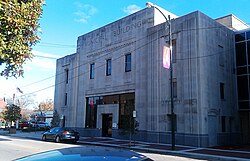Wilson, NC
| Wilson, North Carolina | |
|---|---|
| City | |
| City of Wilson | |

The Wilson Municipal Building in 2010
|
|
| Location within the contiguous United States of America | |
| Coordinates: 35°43′52″N 77°55′25″W / 35.73111°N 77.92361°WCoordinates: 35°43′52″N 77°55′25″W / 35.73111°N 77.92361°W | |
| Country |
|
| State |
|
| County | Wilson |
| Townships |
|
| Incorporated | January 29, 1849 |
| Named for | Colonel Louis D. Wilson |
| Area | |
| • Total | 23.4 sq mi (60.7 km2) |
| • Land | 23.3 sq mi (60.3 km2) |
| • Water | 0.2 sq mi (0.4 km2) |
| Elevation | 108 ft (33 m) |
| Population (2010) | |
| • Total | 49,167 |
| • Estimate (2016) | 49,620 |
| • Density | 2,100/sq mi (810/km2) |
| Time zone | Eastern Time Zone (USA/Canada) (UTC-5) |
| • Summer (DST) | -4 (UTC-4) |
| Zip Codes | 27822, 27880, 27893, 27896 |
| Area code | 252 |
| FIPS code | 37-74540 |
| GNIS feature ID | 1023273 |
| Website | wilsonnc |
Wilson is a city in and the county seat of Wilson County, North Carolina, United States. Situated in the heart of the eastern North Carolina in the Coastal Plain region, around 40 miles east of the capital city of Raleigh, it is served by the interchange of Interstate 95 and U.S. Route 264. Wilson had an estimated population of 49,610 in 2012, according to the Census Bureau.
In the early 21st century, Wilson was ranked as 18th in size among North Carolina’s 500-plus municipalities. From 1990 to 2010, the city population increased by more than 40 percent, primarily due to construction of new subdivisions that attracted many new residents. This has been accompanied by new retail and shopping construction, primarily in the northwestern parts of the city. Wilson is a diverse community; in 2012, the US Census estimated that 48% of the population identified as African American, and 43% as Whites; the remaining 9% includes Latinos and Asians, such as Vietnamese, Chinese and Indian groups. The U.S. Census Bureau estimated in 2012 that nearly 5,000 county residents (7.5 percent) were foreign-born. Of those, nearly 3,000 people, or 62 percent, had entered the U.S. since 2000.
Once a center of tobacco cultivation, the city was widely known as "The World’s Greatest Tobacco Market" in the nineteenth century. In the 21st century, Wilson enjoys a diverse economy based on agriculture, manufacturing, commercial, and service businesses.
Wilson is located at 35°43′52″N 77°55′25″W / 35.73111°N 77.92361°W (35.731093, -77.923509).
According to the United States Census Bureau, the city has a total area of 23.4 square miles (61 km2), of which, 23.3 square miles (60 km2) of it is land and 0.2 square miles (0.52 km2) of it (0.64%) is water.
...
Wikipedia

